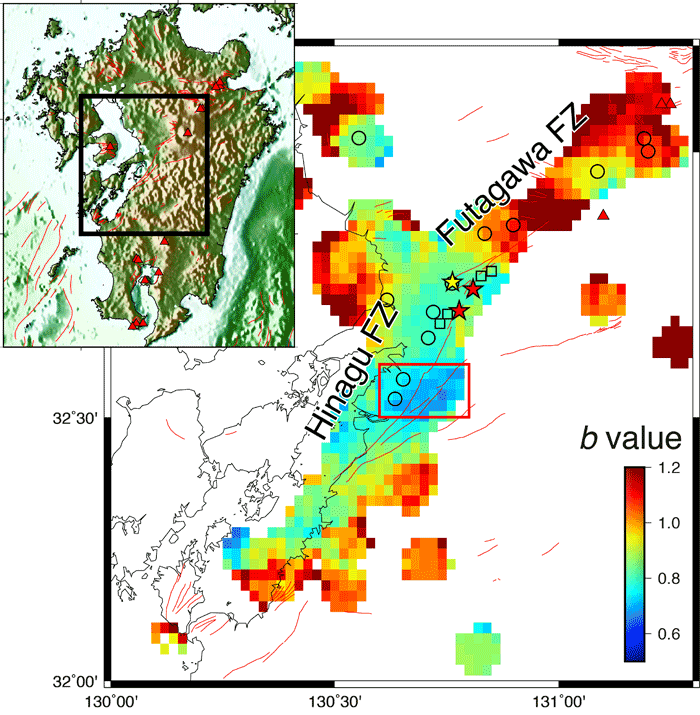A new method to monitor the state of stress on and around the Kumamoto earthquake fault zone: Hazard identification and assessment of the fault zone
A research group of University of Shizuoka, Chubu University, and Tokai University, aiming to evaluate postseismic hazards after the 2016 Kumamoto (Japan) earthquake sequence, succeeded in estimating the current state of stress on and around the causative fault zone, by using a new method that statistically processes a huge amount of seismicity. The study was led by Dr. Kazuyoshi Z. Nanjo, Project Associate Professor and the Leader of Division for Earthquake Prediction Research, Global Center for Asia and Regional Research, University of Shizuoka. Nanjo said, if the currently-high-stressed area on the fault zone will be further stressed, it is likely to be a possible location from which earthquake rupture might initiate.
The research group studied on the “b value”, an indicator that shows the relative proportion of the number of small earthquakes and large earthquakes. In general, it is known that when a high stress is applied to the crust, the number of large earthquakes relatively increases and the b value tends to decrease.
This group statistically analyzed an enormous number of large and small earthquakes from January 2000 to immediately before the start of the Kumamoto sequence, and confirmed an area of low b values near the eventual epicenters of the mainshock (magnitude M7.3) on April 16, 2016 and two large foreshocks (M6.5 and 6.4) on April 14 and 15. In addition, the b value is currently low and decreasing only at the central part of the Hinagu fault zone (one of the causative fault zones) even after the mainshock (Figure 1), so the research group will continue to monitor the spatial and temporal change in b values.
Nanjo said, the method based on b values for estimating the state of stress on and around the fault zone and in the Earth’s crust can be applied to monitoring seismicity associated with the Fujikawa-kako fault zone, the Izu-Tobu volcanoes, and Mt. Fuji underground. He also succeeded in estimating the current state of the stress in and around the focal region of the Nankai Trough megathrust earthquake using the b value (See https://eng.u-shizuoka-ken.ac.jp/news-events/20180328/).
“In contrast to earthquake prediction, the method does not tell us when earthquakes will happen. But it helps to infer, to some extent, possible locations where future earthquakes are likely to initiate, based on scientific evidence”, said Nanjo. He added, “Japan is an earthquake-prone country and earthquakes occur anytime anywhere. So, individuals, local communities, and local governments should thoroughly implement disaster prevention measures in case that earthquakes happen anytime.”
This work was partially supported by JSPS KAKENHI Grant JP 17K18958, the Ministry of Education, Culture, Sports, Science and Technology (MEXT) of Japan, under its Earthquake and Volcano Hazards Observation and Research Program, and the Collaboration Research Program of IDEAS, Chubu University IDEAS201812.
The research group studied on the “b value”, an indicator that shows the relative proportion of the number of small earthquakes and large earthquakes. In general, it is known that when a high stress is applied to the crust, the number of large earthquakes relatively increases and the b value tends to decrease.
This group statistically analyzed an enormous number of large and small earthquakes from January 2000 to immediately before the start of the Kumamoto sequence, and confirmed an area of low b values near the eventual epicenters of the mainshock (magnitude M7.3) on April 16, 2016 and two large foreshocks (M6.5 and 6.4) on April 14 and 15. In addition, the b value is currently low and decreasing only at the central part of the Hinagu fault zone (one of the causative fault zones) even after the mainshock (Figure 1), so the research group will continue to monitor the spatial and temporal change in b values.
Nanjo said, the method based on b values for estimating the state of stress on and around the fault zone and in the Earth’s crust can be applied to monitoring seismicity associated with the Fujikawa-kako fault zone, the Izu-Tobu volcanoes, and Mt. Fuji underground. He also succeeded in estimating the current state of the stress in and around the focal region of the Nankai Trough megathrust earthquake using the b value (See https://eng.u-shizuoka-ken.ac.jp/news-events/20180328/).
“In contrast to earthquake prediction, the method does not tell us when earthquakes will happen. But it helps to infer, to some extent, possible locations where future earthquakes are likely to initiate, based on scientific evidence”, said Nanjo. He added, “Japan is an earthquake-prone country and earthquakes occur anytime anywhere. So, individuals, local communities, and local governments should thoroughly implement disaster prevention measures in case that earthquakes happen anytime.”
This work was partially supported by JSPS KAKENHI Grant JP 17K18958, the Ministry of Education, Culture, Sports, Science and Technology (MEXT) of Japan, under its Earthquake and Volcano Hazards Observation and Research Program, and the Collaboration Research Program of IDEAS, Chubu University IDEAS201812.

Figure 1. A map view of b values based on seismicity over the period from January 2017 to March 2019 reveals an area of low b values (b ~ 0.7, light blue) at the central part of the Hinagu FZ, indicated by the red rectangle. Yellow and red stars show the epicenters of the mainshock and the M6.5-class foreshocks, respectively. Squares and circles indicate M ≥ 5 foreshocks and aftershocks, respectively. Triangles indicate volcanos, and red lines show active faults. The zoomed inset is a map showing the study region (black rectangle) in the Kyushu district. FZ = fault zone. Also see this paper for details.
Paper
Author: K. Z. Nanjo, J. Izutsu, Y. Orihara, M. Kamogawa, and T. Nagao
Title: Changes in Seismicity Pattern Due to the 2016 Kumamoto Earthquakes Identify a Highly Stressed Area on the Hinagu Fault Zone
Journal: Geophysical Research Letters
DOI: 10.1029/2019GL083463
Link: https://agupubs.onlinelibrary.wiley.com/doi/full/10.1029/2019GL083463
Date: August 13, 2019
About Geophysical Research Letters
Geophysical Research Letters publishes high-impact, innovative, and timely communications-length articles on major advances spanning all of the major geoscience disciplines. Papers should have broad and immediate implications meriting rapid decisions and high visibility.
Related links
Geophysical Research Letters
https://agupubs.onlinelibrary.wiley.com/journal/19448007
Global Center for Asian and Regional Research, University of Shizuoka
http://global-center.jp/
International Digital Earth Applied Science Research Center, Chubu Institute for Advanced Studies, Chubu University
http://gis.chubu.ac.jp
Institute of Oceanic Research and Development, Tokai University
http://www.scc.u-tokai.ac.jp/iord/
(9/19/2019)
Paper
Author: K. Z. Nanjo, J. Izutsu, Y. Orihara, M. Kamogawa, and T. Nagao
Title: Changes in Seismicity Pattern Due to the 2016 Kumamoto Earthquakes Identify a Highly Stressed Area on the Hinagu Fault Zone
Journal: Geophysical Research Letters
DOI: 10.1029/2019GL083463
Link: https://agupubs.onlinelibrary.wiley.com/doi/full/10.1029/2019GL083463
Date: August 13, 2019
About Geophysical Research Letters
Geophysical Research Letters publishes high-impact, innovative, and timely communications-length articles on major advances spanning all of the major geoscience disciplines. Papers should have broad and immediate implications meriting rapid decisions and high visibility.
Related links
Geophysical Research Letters
https://agupubs.onlinelibrary.wiley.com/journal/19448007
Global Center for Asian and Regional Research, University of Shizuoka
http://global-center.jp/
International Digital Earth Applied Science Research Center, Chubu Institute for Advanced Studies, Chubu University
http://gis.chubu.ac.jp
Institute of Oceanic Research and Development, Tokai University
http://www.scc.u-tokai.ac.jp/iord/
(9/19/2019)


